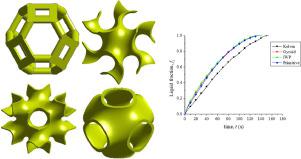International Journal of Heat and Mass Transfer ( IF 5.0 ) Pub Date : 2021-02-09 , DOI: 10.1016/j.ijheatmasstransfer.2021.121001 Zahid Ahmed Qureshi , Emad Elnajjar , Oraib Al-Ketan , Rashid Abu Al-Rub , Salah Burhan Al-Omari

|
Metal foams have been used extensively to enhance the thermal conductivity of phase change materials (PCMs) in thermal energy storage (TESs) systems and thermal management systems (TMSs). The conventional metal foam structure, referred to commonly as the Kelvin cell, has been characterized well and the effects of its geometric and macroscopic parameters, such as porosity, pore size, and surface area density, on the performance of metal foam–PCM composites have been investigated extensively. With the advent of additive manufacturing technology, any intricate and complex architecture can be manufactured easily, thereby opening doors for the utilization of several other candidate foams and structures in TES systems and TMSs. In this work, three triply periodic minimal surface (TPMS)-based foams (Gyroid, IWP, and Primitive) were used in a finned metal foam–PCM (FMF–PCM) system, and their heat transfer performances were compared with that of the conventional metal foam. Pure conduction and natural convection-based transient phase change simulations were performed under isothermal conditions. The results indicated that all TPMS structures exhibited enhanced heat transfer performance by reducing the melting time of the PCM and increasing the average heat transfer coefficient. Hence, TPMS-based foams offer great promise for use in TES systems and TMSs.
中文翻译:

翅片金属泡沫相变材料(FMF-PCM)系统具有三重周期性最小表面(TPMS)的传热性能
金属泡沫已被广泛用于增强热能存储(TES)系统和热管理系统(TMS)中相变材料(PCM)的导热性。常规的金属泡沫结构(通常称为开尔文电池)已被很好地表征,并且其几何和宏观参数(例如孔隙率,孔径和表面积密度)对金属泡沫-PCM复合材料的性能具有影响被广泛调查。随着增材制造技术的出现,任何复杂的复杂结构都可以轻松制造,从而为在TES系统和TMS中利用其他几种候选泡沫和结构打开了大门。在这项工作中,使用了基于三重周期性最小表面(TPMS)的泡沫(Gyroid,IWP,和Primitive)用于翅片金属泡沫-PCM(FMF-PCM)系统,并将其传热性能与常规金属泡沫进行了比较。在等温条件下进行了纯传导和基于自然对流的瞬态相变模拟。结果表明,所有TPMS结构都通过减少PCM的熔化时间和增加平均传热系数而表现出增强的传热性能。因此,基于TPMS的泡沫为TES系统和TMS提供了广阔的前景。结果表明,所有TPMS结构都通过减少PCM的熔化时间和增加平均传热系数而表现出增强的传热性能。因此,基于TPMS的泡沫为TES系统和TMS提供了广阔的前景。结果表明,所有TPMS结构都通过减少PCM的熔化时间和增加平均传热系数而表现出增强的传热性能。因此,基于TPMS的泡沫为TES系统和TMS提供了广阔的前景。











































 京公网安备 11010802027423号
京公网安备 11010802027423号